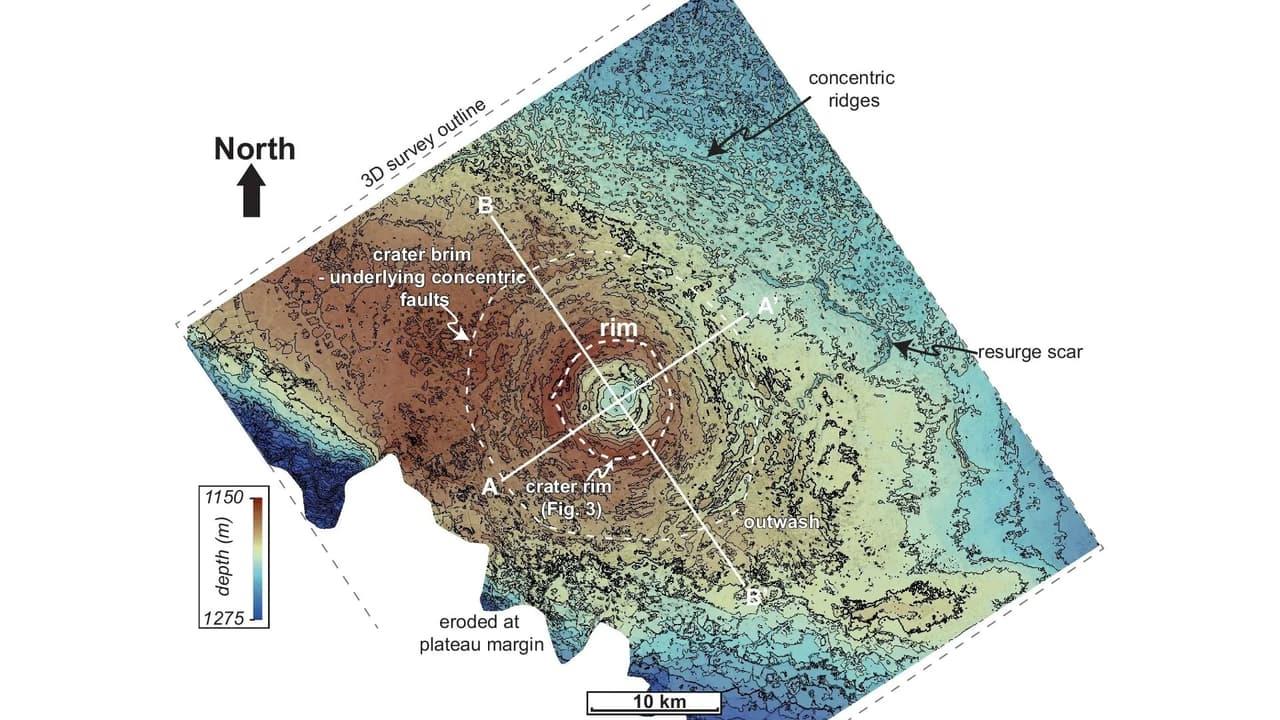
Massive Asteroid Crater Discovered Deep Beneath The Atlantic Ocean
A colossal asteroid impact crater, buried deep beneath the Atlantic Ocean, has finally been confirmed using high-resolution 3D seismic imaging. The 9-kilometer-wide (5.6-mile) structure-known as the Nadir Crater-formed roughly 66 million years ago, coinciding with the same catastrophic era that wiped out the dinosaurs.
A Window into a Prehistoric Catastrophe
The newly released data from researchers at Heriot-Watt University reveals in unprecedented detail how this massive impact unfolded beneath the ocean. Molten rock surged upward, enormous tsunamis towered over 800 meters (2,600 feet) high, and the seafloor violently reshaped itself in the chaotic minutes that followed the collision.
Published in Nature Communications Earth & Environment, the findings offer one of the most complete looks ever captured of an underwater impact crater.
Discovery of the Nadir Crater
Dr. Uisdean Nicholson of Heriot-Watt University first spotted the Nadir Crater in 2022 while studying seismic reflection data from the seabed off the coast of Guinea, West Africa. The circular depression-spanning more than 8.5 kilometers across-immediately raised the possibility of an ancient asteroid strike.
Subsequent collaboration with international geologists and planetary scientists confirmed that the crater was indeed caused by an asteroid, estimated to be 450–500 meters wide, striking the ocean at nearly 20 kilometers per second (72,000 km/h).
From Grainy Scans to 3D Revelation
Earlier images of the crater were comparable to an ultrasound's fuzzy outline. The new 3D seismic scans, collected by the global geophysical company TGS, have transformed that blurry view into an extraordinary digital reconstruction.
“It's like going from a blurry ultrasound to a full 3D image where you can see every layer,” said Dr. Nicholson.“We can now peel back the layers of sediment and visualize the crater in exquisite detail.”
A Violent Minute-by-Minute Sequence
The enhanced data allowed scientists to reconstruct the catastrophic sequence that followed impact:
- Initial Impact: The asteroid struck the seabed at a shallow angle from the northeast. Crater Formation: A massive bowl-shaped cavity formed instantly, followed by a central uplift as molten rock surged upward. Seafloor Collapse: The surrounding sediments liquefied, flowing inward to create a distinct rim or“brim.” Mega-Tsunamis: Tsunami waves-some over 800 meters high-swept across the Atlantic, crashing back and forth around the impact site. Seismic Chaos: Tremors from the collision triggered underwater landslides and widespread fracturing of the seabed.
A Rare Natural Laboratory
According to Dr. Nicholson, this is the first time scientists have obtained such a complete 3D view of a marine impact crater.“There are only about 20 confirmed oceanic craters on Earth, and none have been imaged with this level of precision,” he noted.
The team has applied to IODP3, an international ocean drilling program, to collect core samples from the site. These samples could reveal how the impact materials cooled, the pressures involved, and the exact timeline of post-impact processes.
Global Collaboration and Significance
Dr. Sean Gulick from the University of Texas at Austin, an expert in planetary impacts, called the images“a phenomenal opportunity to understand how craters evolve underwater and compare them with impacts on other worlds.”
Dr. Veronica Bray from the University of Arizona added that Earth's atmosphere and erosion usually erase much of the evidence left by ancient impacts.“On the Moon, craters remain pristine but lack internal data. On Earth, we have the structure but rarely such a preserved example. Nadir gives us both.”
Could It Happen Again?
The Nadir impactor was similar in size to asteroid Bennu, a 400-meter-wide near-Earth object currently monitored by NASA. Bennu poses the highest known risk of a future collision, though the odds remain slim-about 1 in 1,750 by the year 2300, with the most significant potential date being September 24, 2182 (a 1 in 2,700 chance).
While such events are extraordinarily rare, the Nadir Crater provides a sobering reminder of Earth's dynamic and sometimes violent history-and an unmatched opportunity for scientists to study how life on our planet has endured cosmic catastrophes.
Legal Disclaimer:
MENAFN provides the
information “as is” without warranty of any kind. We do not accept
any responsibility or liability for the accuracy, content, images,
videos, licenses, completeness, legality, or reliability of the information
contained in this article. If you have any complaints or copyright
issues related to this article, kindly contact the provider above.


















Comments
No comment